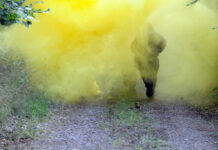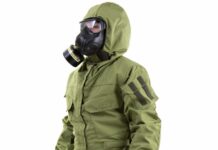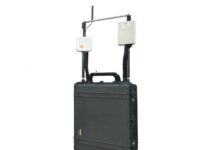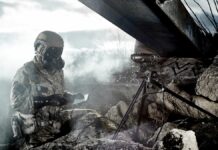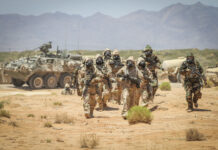CBRN agents can suppress a naval vessel’s ability to operate efficiently. Because of the threat to the crew much more than the actual physical infrastructure of a ship, collective protective is often the primary component of naval CBRN defence.
Land warfare gets most of the attention in military CBRN defence, and for several good reasons. Within defence budgets, protecting land forces leads to the largest outlays of expenditure on protection, detection, decontamination, and other necessary elements of CBRN defence. Armies have CBRN defence troops and most of them have devoted force structure and professional schooling to CBRN defence. Navies tend to have lesser emphasis on CBRN defence.
Background to CBRN in the Naval Environment
Historically, CBRN defence in naval environments was strongest in the Cold War. This was particularly the case in the navies of the traditional nuclear powers like the USA, USSR, France, and Britain. Even then, the emphasis was very much on the R/N part of CBRN. However, the end of the Cold War has not seen the end of concern for protection against CBRN hazards. Navies ignore CBRN threats at their peril.
Chemical warfare agents, biological agents, and radiological particles (such as fallout from a nuclear weapon explosion) will not fundamentally damage a naval vessel. However, they can suppress a naval vessel’s ability to operate efficiently. Non-persistent chemical agents such as Sarin could cause immediate casualties on a ship, and a ship’s ventilation systems might even carry the hazard throughout.
Persistent chemical agents and radiological particles could cause contamination of exposed surfaces for days or even weeks. This could have the effect of interdicting flight operations on an aircraft carrier and forcing crew to work in cumbersome protective clothing. All of the CBRN threats pose the prospect of illness and injury to crew over a protracted period of time from persistent threat materials, as many of the CBRN threats provide chronic cumulative effects. The evolution of smaller but more specialised crews means that some critical roles may have only one or two people trained to do them on some ships.
A Higher Vulnerability
In particular, naval vessels have some degree of higher vulnerability to biological attack than their land-based comrades in armies and air forces. Crews live in confined proximity. Air handling systems act to concentrate biological agents, unless the whole ship is heavily filtered. Recirculation of air can spread pathogens around a ship. Ships at sea cannot quickly replace dead or sick crew members. Additionally, a ship’s medical staff and facilities can be easily overcome by casualties in some CBRN scenarios.
Because of these varied threats to the crew, much more than the actual physical infrastructure of a ship, collective protective is often the primary component of naval CBRN defence. (This author discussed other aspects of naval CBRN defence, such as detection and decontamination in the October 2020 issue of this magazine’s sister publication Maritime Security and Defence.) Collective protection is the provision of protection in a large space. This is opposed to “individual protection” which is generally composed of protective clothing and masks/respirators. Individual protection also plays a role in naval CBRN defence, but it tends to not vary greatly from individual protection for land forces and firefighting.
Components of Collective Protection
Collective protection in ships (or in building or land vehicles for that matter) is simple in principle. It should be noted that NATO has played a valuable role in standards in this area as well. NATO Allied Engineering Publication 54 lays out standards for collective protection that industry can follow. Collective protection (‘colpro’ in industry jargon) for spaces and volumes, such as ships and buildings consists of several components. These components include air handling equipment designed to provide a high volume of clean filtered air at a pressure higher than outside, large filters, and all of the ancillary modifications and fittings needed to ensure the airtight integrity of spaces. All three components will be addressed below.
Air-Handling
The first component is air-handling. All but the smallest and most basic vessels have some kind of ventilation system in crew and operational spaces. Naval vessels are generally required to operate in a variety of climates. This requires humidity reduction, so some form air conditioning is fairly standard. As a result, ship designs incorporate air intakes, air handling, recirculation, and exhaust requirements. The key issue is that collective protection imposes a requirement to operate at an overpressure, so that air flow out instead of in through leaks and openings. It also has air flowing through filters, which give resistance. Therefore, a vessel with collective protection needs to have fair more extensive airflow than a non-protected vessel might have or require. This, in turn, drives space and power requirements.
Filtration
The next component is filtration. While modern non-Collpro ventilation systems will have some degree of filtration, the sorts of filters necessary for CBRN protection are far more extensive and expensive than commercial filtration. High-grade commercial filtration can provide a reasonable degree of protection against biological aerosols and radiological particulates. However, chemical warfare agents necessitate elaborate filtration in order to absorb gases and vapours. Collective protection generally stacks several degrees of filtration together so that the more expensive chemical filters are not fouled by particles that can be screened out by cheaper and more easily replaced particle filters.
For CBRN filtration, the state of the art remains deep-bed charcoal filtration, a time-honoured technology dating back a century. These are, in most respects, a large version of the filter that you might find on a soldier’s protective mask. The most recent technical advances involve “regenerative filters” – filters that, as the name suggests, effectively renew themselves and therefore have a longer service lifetime between replacements than simple charcoal filters.
Airtight Integrity
The third component is the least glamourous one. Higher volumes of air and filtration are of only limited value if the spaces on a vessel to be protected are reasonably air-tight. Overpressure cannot be maintained if too much air leaks out. Filtration is pointless if a stiff breeze carries vapour or particles into compartments on a ship. Therefore, it is important to ensure airtight integrity of compartments in the same way that naval vessels handle watertight integrity.
This means reviewing every way in which air can enter or leave a space or compartment. It adds up to a lot of gaskets around a lot of hatches and lots of plugging of small holes. This effort also means a burden on maintenance and inspections because damage, erosion, or other wear-and-tear over time to gaskets and hatch hardware can greatly reduce the protective value of a system. It should also be noted that instrumentation is needed on a vessel as well. Air flow and air pressure, in particular the pressure differentials between inside and outside air pressures, need to be monitored to ensure that collective protection is effectively maintained.
Two Approaches
There are two main approaches to designing CBRN collective protection into a vessel. One is to go for an all-vessel approach and attempt to provide filtered overpressure throughout the vessel. This can be prohibitively expensive. It can prove impossible in retrofits and is much easier to design from the beginning with a new vessel. But naval vessels tend to have long service lifetimes and often undergo numerous retrofits during their lifespan. In addition, larger vessels with large volumes on them, such as aircraft carriers, will prove to be too difficult to protect in totality.
A far more commonplace approach, both in new designs and in retrofits, proves to be more manageable from an engineering approach. One can identify specific areas within a ship to protect and form a protected “Citadel” that is hardened against CBRN hazards with collective protection. As a practical matter, this is cheaper and easier to undertake. This citadel approach has become the industry standard. A ship’s combat information centre, fire control spaces, and medical areas are commonly fortified as such citadels. With a larger ship, setting up a number of citadels within a ship is still cheaper and easier than protecting the entire ship.
Operational Cost
One serious issue with collective protection is operational cost. Maintenance for such systems can be both time-consuming and expensive. Replacement of filters can be costly. Even running the system with clean air will gradually reduce the operational effectiveness of the filters. Because of this, many navies have instituted operating procedures that only use the systems part of the time. However, this begs the question of when to turn on the system. Detection systems have a place on naval vessels to help make such a decision.
The Collective Protection Market
Several companies do a lot of work in the CBRN filtration and collective protection market space. Some of them specialise in naval work, while others are more general-purpose military collective protection providers. At the lowest level, individual compartments on small vessels, the hardware is not radically different than that installed in, say, a tank or military ambulance. This is not an area of major specific programmes and expenditures. Rather, this sort of equipment is buried well within the construction and/or retrofit of major naval vessels and done by subcontractors. However, this is a space worth surveying and there are several important manufacturers in this area.
It is difficult to define a clear world market leader in this segment, in part due to the fact that ship construction and retrofits are complex projects and collective protection is buried several layers down in overall project. However, some industrial players are worthy of mention. HDT Global (USA) is a market leader in this military collective protection overall and has not neglected the naval market. They have had sold numerous systems to the US Navy. In addition, they are an industry leader in the instrumentation, tools, and components needed to install or retrofit naval collective protection. HDT easily does tens of millions USD worth of contracting in this area.
European Players
Within continental Europe, several manufactures work in this space. ENGIE-AXIMA Marine Offshore (France) is a time-honoured contractor in naval collective protection. Their CBRNflex 3600 is a well-regarded naval protection product. They also produce some modular systems for smaller vessels and a variety of accessory equipment. Heinen & Hopman (Netherlands) is a major player in maritime ventilation and air conditioning. They make CBRN filtration systems for a variety of naval craft. Van Halteren Specialty Products (Netherlands) sells a full range of filter systems ranging from small to large. Their filters range from 900 cubic metres per hour all the way up to 3600. Even the largest naval requirements could be met by Van Halteren’s product line.
Another name of note in this sector is Beth-El Industries (Israel). They are an established player in the military CBRN collective protection market. Israel, for domestic protection reasons, takes collective protection seriously and Beth-El have applied their considerable land-based expertise to ships. A number of firms in the UK serve the collective protection market. EMCEL (UK) is a well-established name in the production of CBRN filters of various sizes and configurations for collective protection, and makes NATO-standard filter elements that are often integrated into maritime systems. MDH (UK) focuses on the land-based market, but advertises that they can provide solutions in the naval space as well. An arm of BAE had been involved in Royal Navy collective protection systems as well.
The Future?
As with any part of the CBRN defence market space, the future depends on technical investments. In turn, these investments are driven by perceptions of the threat and reaction to actual incidents. Overall, collective protection in navies remains a relatively modest area for market expansion because of relatively low priorities afforded to such threats. The biggest area for improvements in this field is in regenerative filtration. Filter elements that can purge and clean themselves will have significantly longer lifespan, both in standby and in active modes than the century-old charcoal filter systems that are still the mainstay of collective protection both on land and sea. This author’s prediction is that regenerative filters will eventually become the industry standard.




